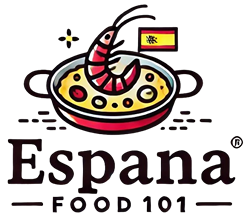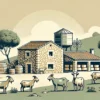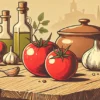Paella Valenciana stands apart from other varieties of paella because it hails from the region of Valencia in Spain, where the dish has deep cultural roots. This dish isn’t just about rice and seafood (as some may think). It’s a carefully crafted recipe using specific ingredients to create a symphony of flavors. Each element plays a pivotal role in bringing out the essence of this Valencian staple.
People often ask what makes an authentic Paella Valenciana, and the answer lies in the ingredients themselves. There’s a precise balance between the rice, vegetables, meats, and traditional seasonings. Let’s break down each of these key elements.
The Role of Rice in Paella Valenciana
The foundation of any paella dish is the rice. In Paella Valenciana, the choice of rice can make or break the dish. The specific variety used is called “Bomba” rice, known for its ability to absorb liquids without becoming mushy. Bomba rice has short, plump grains that remain firm even after cooking, giving the dish its signature texture.
Cooking paella requires patience and careful timing to allow the rice to soak in all the rich flavors of the broth and other ingredients. Without the right rice, your dish may lack the authentic texture that defines Paella Valenciana.
Why Bomba Rice Is Essential
Bomba rice is critical because of its unique absorption quality, taking in more broth than regular rice varieties. This ensures that each grain is flavorful while retaining the firmness necessary for a good paella. Using regular rice would result in a dish that’s either too soggy or lacking in flavor.
Helpful Hint:
When purchasing rice for Paella Valenciana, look for rice specifically labeled as “Bomba.” If you can’t find Bomba rice, another good option is Calasparra rice. Both types have the perfect texture for this dish, ensuring your paella comes out just right.
Key Differences Between Bomba and Calasparra Rice
| Rice Type | Absorption Rate | Grain Size | Cooking Time | Origin |
|---|---|---|---|---|
| Bomba Rice | Absorbs 2-3 times its volume in liquid, ideal for paella | Short and plump | 18-20 minutes | Valencia, Spain |
| Calasparra Rice | Absorbs more than 3 times its volume in liquid | Short but slightly thicker than Bomba | 20-22 minutes | Murcia, Spain |
Traditional Meats Used in Paella Valenciana
Authentic Paella Valenciana includes a mix of meats—most notably rabbit and chicken. While seafood paellas have their own allure, Valencians stick to this classic combination of proteins for the traditional dish. These meats not only add depth to the flavor but also create a rich, hearty texture that pairs beautifully with the rice.
Why Rabbit and Chicken?
Rabbit, although less common in some cuisines, adds a distinct taste and texture to Paella Valenciana. It’s lean and subtly gamey, complementing the milder flavor of chicken. Together, they form the perfect protein base, balancing the other ingredients and elevating the dish to a new level.
Helpful Hint:
If rabbit is hard to find, you can substitute it with more chicken. However, for the most authentic experience, sourcing rabbit from a local butcher will keep your dish true to its Valencian roots.
Key Vegetables and Legumes in Paella Valenciana
Vegetables and legumes are crucial to Paella Valenciana, bringing not only flavor but also texture to the dish. The most traditional vegetables used include green beans and “garrofó” (a large, flat Valencian bean).
The Importance of Garrofó Beans
Garrofó beans are unique to Valencian cuisine and are an irreplaceable ingredient in Paella Valenciana. Their slightly creamy texture contrasts with the firmer rice, creating a dynamic mouthfeel that adds depth to each bite. Along with garrofó, green beans (typically “ferradura” or “judía verde”) add a subtle crispness, providing a refreshing balance to the meats and rice.
The Perfect Broth: The Heart of the Dish
A key ingredient that ties all these elements together is the broth. In Paella Valenciana, the broth is traditionally made by simmering chicken and rabbit with various aromatics to create a deep, savory base. This broth is what infuses the rice with flavor and keeps it from drying out during the cooking process.
Using high-quality saffron threads in the broth is a non-negotiable when it comes to creating an authentic paella. Saffron not only provides a golden color but also imparts a delicate floral note that elevates the entire dish.
Stats:
Did you know that Spain produces approximately 70% of the world’s saffron? The majority of this comes from the Castilla-La Mancha region. Authentic saffron adds a level of richness to your Paella Valenciana that substitutes like turmeric simply can’t replicate.
How to Use Olive Oil and Sofrito
Olive oil is another essential ingredient in Paella Valenciana, providing the base for the cooking process. It’s used to sear the meats and create a flavorful foundation for the sofrito—a mixture of finely chopped tomatoes, garlic, and onions cooked until it reaches a deep, caramelized state.
This sofrito forms the aromatic backbone of the dish, infusing the rice with a savory, slightly sweet undertone. It’s critical to take the time to cook the sofrito properly, allowing the flavors to meld before adding the other ingredients.
Saffron: The Signature Spice of Paella Valenciana
No discussion of Paella Valenciana would be complete without mentioning saffron. This prized spice not only gives the dish its characteristic golden hue but also adds a unique, delicate flavor that can’t be mimicked by any substitute. A small amount goes a long way, and authentic saffron threads are worth the investment for a true Paella Valenciana.
Why Saffron Is Irreplaceable
While some may be tempted to use turmeric or paprika to mimic saffron’s color, there’s no substitute for the real thing. Saffron threads provide a subtle earthy flavor with floral notes, and without them, your dish won’t have the depth or complexity it needs.
The Traditional Paella Pan and Cooking Method
To make an authentic Paella Valenciana, you also need the right equipment: a wide, shallow paella pan known as a “paellera.” This allows the rice to cook evenly and develop the famous “socarrat,” or crispy bottom layer of rice. Cooking over an open flame, often outdoors, is the traditional method in Valencia, giving the dish a slightly smoky flavor that’s hard to achieve in a conventional kitchen.
Helpful Hint:
If you don’t have access to a paellera, use a wide, shallow skillet as a substitute. Just make sure not to overcrowd the pan, as this will prevent the rice from cooking properly and hinder the development of socarrat.
How to Achieve the Perfect “Socarrat”
One of the most coveted aspects of a well-made Paella Valenciana is the socarrat, the crispy layer of caramelized rice at the bottom of the pan. Achieving this requires attention to detail during the final stages of cooking. After the liquid has been absorbed and the rice is nearly done, the heat should be increased slightly to allow the bottom to crisp up without burning.
The trick is to listen for a light crackling sound coming from the pan—this means the socarrat is forming. Resist the urge to stir or disturb the rice at this point, as this will disrupt the caramelization process.
Can You Make Socarrat Without an Open Flame?
While traditional Paella Valenciana is cooked over an open flame, it’s still possible to achieve socarrat on a stovetop. Use a broad, shallow pan, ensure an even heat distribution, and avoid adding too much liquid at the end of the cooking process. Remember, patience is key—don’t rush the final step.
Helpful Hint:
If you’re using a stovetop, a good way to ensure even heat is to rotate the pan gently while cooking. This helps distribute the heat more evenly, reducing the risk of burning one part of the socarrat while leaving other areas undercooked.
The Importance of Seasoning with Paprika and Saffron
Seasoning Paella Valenciana is all about striking the right balance. Two key spices—sweet paprika and saffron—are responsible for most of the dish’s flavor profile. Sweet paprika adds a warm, smoky undertone, while saffron delivers its unmistakable aromatic richness.
It’s important to add the paprika just before adding the liquids. This prevents the spice from burning, which can create an unpleasant, bitter taste. The saffron, on the other hand, should be steeped in warm broth for a few minutes before being added to the rice. This technique helps to release the maximum flavor and color from the saffron threads.
Why You Shouldn’t Skip the Saffron
Although saffron can be pricey, skipping it will rob your Paella Valenciana of its traditional flavor. Even a small pinch of saffron goes a long way and brings a complexity to the dish that no other spice can replicate.
Stats:
Spain produces around 1.5 tons of saffron annually, with La Mancha being one of the most famous regions for cultivation. While this might not seem like much, it’s the labor-intensive harvesting process that makes saffron such a valuable and essential part of Paella Valenciana.
Should You Add Seafood to Paella Valenciana?
This is a common question for those new to paella. While seafood is often associated with paella dishes, it’s important to note that traditional Paella Valenciana is strictly a land-based dish. The inclusion of rabbit, chicken, and specific vegetables defines this version of paella, and adding seafood would turn it into a different variety of paella altogether.
If you’re looking to stick to the authentic Paella Valenciana recipe, it’s best to avoid adding any shrimp, mussels, or other seafood. Save those for a “Paella de Marisco” (seafood paella) if you’re craving that ocean flavor.
Cooking Techniques for the Perfect Paella Valenciana
Aside from the ingredients, cooking technique plays a significant role in achieving the authentic taste of Paella Valenciana. The first step is to brown the meats, creating a flavorful base. After that, it’s all about layering the ingredients—starting with the meats, followed by the sofrito, then the rice, and finally, the broth.
The cooking process should happen in stages, ensuring each ingredient has enough time to release its flavor. Once everything is in the pan, resist the temptation to stir. Unlike risotto, paella is meant to cook undisturbed so that the rice can absorb the flavors evenly and the socarrat can develop on the bottom.
Timing Is Everything
Timing is crucial when cooking paella. You want the rice to be tender but still have a slight bite to it, and this happens only when the ingredients are added at the right intervals. A common mistake is rushing through the steps, which can result in unevenly cooked rice or overcooked vegetables.
Why Valencian Water Matters
Water might seem like a minor detail, but in traditional Paella Valenciana, even the water can make a difference. Valencian water is known for its specific mineral composition, which helps create the ideal cooking environment for the rice. While it might be impossible to source Valencian water unless you’re in Spain, using high-quality, filtered water will ensure you don’t interfere with the rice’s absorption process.
Helpful Hint:
If you can’t source water from Valencia, using bottled spring water is a good alternative. It’s less likely to contain the chlorine or other chemicals found in tap water, which can affect the flavor of your paella.
Paella Valenciana Variations: Is There Room for Experimentation?
While sticking to tradition is key for authentic Paella Valenciana, many home cooks ask whether there’s room for experimentation. The truth is, this dish has been passed down through generations in the Valencian region, and adding or omitting certain ingredients can quickly turn it into something else.
That said, you can still adapt the dish slightly to accommodate what’s available to you. If garrofó beans aren’t accessible, for example, you can use a similar legume like lima beans. Just be mindful of keeping the dish close to its roots.
Why Cooking Paella Valenciana Outdoors Elevates the Flavor
Paella Valenciana is traditionally cooked outdoors, often over an open flame. This not only adds to the flavor but also creates a social, festive atmosphere around the cooking process. The slight smokiness imparted by the fire brings an extra depth of flavor that’s hard to replicate in an indoor kitchen.
If cooking outdoors isn’t an option, you can still make a fantastic paella on your stovetop. Just remember, patience and careful heat control are key.
FAQs
Wrapping Up
Creating an authentic Paella Valenciana is more than just following a recipe; it’s about respecting the traditions and carefully selecting the right ingredients to bring out the unique flavors of this iconic Spanish dish. By using high-quality Bomba rice, traditional meats like rabbit and chicken, and essential seasonings like saffron and paprika, you can recreate this Valencian classic at home. Remember, patience and attention to detail are crucial in every step, from preparing the sofrito to achieving the perfect socarrat.
Paella Valenciana offers a wonderful opportunity to gather friends and family, sharing not only a meal but an experience rooted in Spanish culture. With the right techniques and ingredients, you’ll master the art of paella and impress your guests with a dish that is as authentic as it is delicious. So next time you’re craving a taste of Spain, reach for your paella pan and embrace the challenge—you won’t regret it.







